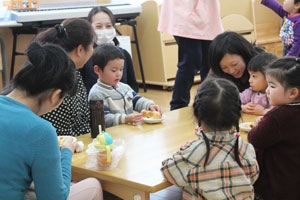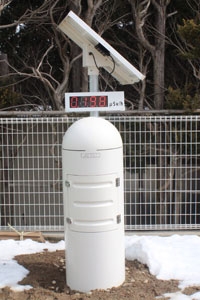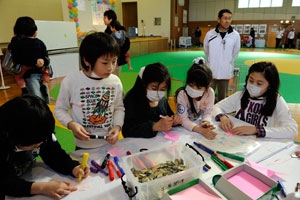Living in the shadow of Fukushima
by Patrick Fuller
2012/03/26

At first sight the Azuma Nursery school in Fukushima city appears like any other Japanese nursery school; immaculately clean, well organised with happy children looked after by smiling attentive carers. But appearances are deceptive. The turf in the school playground has been ripped up, and a large solar powered radiation monitor now stands by the disused climbing frame. Since the disaster at the Fukushima Daichi nuclear reactor one year ago, most of the children here have spent most of their year indoors due to fears surrounding the possible health effects of radiation levels which are monitored on an hourly basis. According to a government guideline, if the radiation monitor reads between 0 - 1 microsieverts per hour it’s considered safe for children to play outside for one hour. Today the reading is 0.191, yet most mothers are still reluctant to let their children outside.
(Photo: Since the climbing frame has been exposed to radiation, children are not allowed to play with it in Azuma Nursery school.)

The Fukushima disaster has changed people’s lives here irrevocably. The school Principal Sumiko Nanashima feels that while the children understand why they can’t play outside, it’s their mothers who are bearing the most stress with the constant worry about their children’s welfare. I have a chance to speak with a group of the mothers, all of who are very vocal. Emiko Goto, clearly feels aggrieved that so much attention has been paid to people who had to evacuate from their homes within the exclusion zone and not on the welfare of residents of Fukushima city who are also suffering.
(Photo: The nursery school occasionally open their school to parents who raise their children at home.)
“Sometimes we don’t know what to believe. The government says one thing then the media write stories exaggerating the situation. You can’t decide what to do with all the different information coming out about the radiation”, she says.
Emiko and most of the other mothers have become far more health conscious in the past year. They don’t buy food produced in Fukushima and most of the supermarkets no longer stock local produce.

When I ask her if she’d move away from the city if she had the option, she answers that her husband’s job is here and she couldn’t leave her elderly parents, but she’s obviously concerned. “It took us 10 years to have a baby and my child is my only hope in life”.
The nursery is also rigorous in checking the radiation of all food and water given to the children. “It’s affecting us all”, says Sumiko Nanashima, “I want to give parents the right message, and I want the kids to be brought up normally, but I can’t be sure whether the swings or the climbing frame are contaminated, there are simply no benchmarks provided by the government”.
To remedy the situation most mothers take their children to a neighbouring prefecture once a week to allow them to play outdoors. The Japanese Red Cross has also helped to ease the pressure by recently organising a special indoor playground called ‘Smile Park’ which was attended by nursery schools in the city.
(Photo: A 24-hours radiation monitor stands at the playground of the Azuma Nursery school. This device was set by the government. )

“The Smile Park really lifted people’s spirits”, says Sumiko Nanashima. “If the children can’t run around outside I’m worried that their physical development will be affected”.
The Japanese Red Cross has taken another step towards allaying local people’s fears about radiation contamination by providing specialised machines that measure caesium levels for every day food items. A total of 100 devices are being provided to local government offices where members of the public can bring water, rice and other local foodstuffs to be checked. At the central Fukushima monitoring centre test results show that although most produce is within safety limits, about nine foods tested from certain parts of the prefecture have been placed on a restricted list meaning that they can’t be sold. These include wild mushrooms, wild game, rice and fish.
But despite living 60 kms away from the wrecked reactor, the picture you receive in Fukushima is a mixed one. Some local mayors are now lobbying for local residents to return to some areas within the exclusion zone while others maintain that the risks remain too high. For ordinary residents living in Fukushima city itself, opinion remains divided. Young mothers like Emiko are clearly concerned whereas 19 year old student Nobuhiro Kanno remains non-plussed. “I don’t know what all the fuss is about. Some friends in Tokyo call me up and are really worried for me. I think the media has created a negative image of Fukushima. Life goes on as normal here”.
(Photo: The Japanese Red Cross hosted an indoor playground "Smile Park" for 2 weeks to provide children an opportunity to play in Fukushima.)















